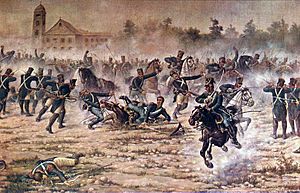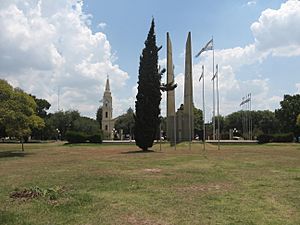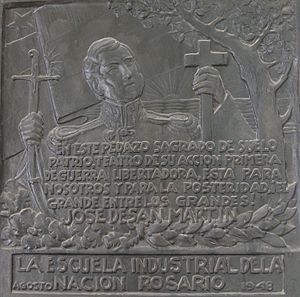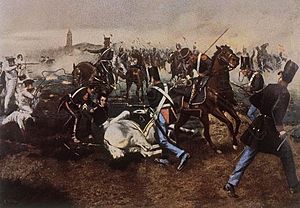Battle of San Lorenzo facts for kids
Quick facts for kids Battle of San Lorenzo |
|||||||
|---|---|---|---|---|---|---|---|
| Part of the Second Banda Oriental campaign | |||||||
 Painting of the battle by Ángel della Valle. |
|||||||
|
|||||||
| Belligerents | |||||||
| Commanders and leaders | |||||||
| Strength | |||||||
| 140 mounted grenadiers 70 militia |
250 Montevideo militia 2 cannons |
||||||
| Casualties and losses | |||||||
| 16 killed 22 wounded |
40 killed 14 wounded & captured 2 cannons |
||||||
The Battle of San Lorenzo was a short but important fight that happened on 3 February 1813. It took place in San Lorenzo, Santa Fe, which is now part of Argentina. This battle was a key moment in the Spanish American wars of independence.
In this battle, a group of Spanish soldiers, called royalists, faced off against a new Argentine army unit. The royalists were militiamen from Montevideo, led by Captain Antonio Zabala. They were defeated by the Regiment of Mounted Grenadiers, led by José de San Martín. This was the very first battle for San Martín and his grenadiers. It was their "baptism by fire," meaning their first experience in combat.
At the time, Montevideo was a Spanish stronghold and was being surrounded by patriot forces. To get supplies, the Spanish ships would raid towns along the nearby rivers. San Martín and his new regiment secretly followed these ships to San Lorenzo. They hid inside the San Carlos Convent overnight. San Martín used the convent's tower to watch the enemy ships and plan his attack. The battle began at dawn with a surprise attack. The grenadiers used a special tactic called a "pincer movement" to surround the enemy. San Martín himself fell from his horse during the fight and was almost killed. But two brave soldiers, Juan Bautista Cabral and Juan Bautista Baigorria, saved him. The royalists were defeated, but they continued to raid other villages for a while after this battle.
This battle was the only one San Martín fought in what is now Argentina. Today, the city of San Lorenzo has memorials to remember the battle. It is also famous because of the "San Lorenzo march," a well-known military song.
Contents
Why the Battle Happened
In 1812, Argentina was fighting for its independence. The city of Montevideo was still controlled by the Spanish. It was being surrounded by patriot armies from Buenos Aires and Uruguay. However, the Spanish in Montevideo had strong ships. They used these ships to raid towns along the Paraná River and Uruguay River to get food and supplies.
To stop these raids, the Argentine government told José de San Martín to act. San Martín had just arrived in Buenos Aires and had formed a new army unit called the Regiment of Mounted Grenadiers. He trained his soldiers using the newest military tactics from Europe.
San Martín and his 120 grenadiers secretly moved from Buenos Aires towards San Lorenzo. They marched at night to avoid being seen by the Spanish ships. Along the way, they were joined by 70 local militia soldiers. San Martín learned that the Spanish planned to attack the San Carlos Convent in San Lorenzo. He rushed his troops to get there first.
The whole army arrived at the convent on the night of February 2nd. They hid inside the building, staying quiet and without lights. San Martín used a special telescope to watch the enemy ships and plan his attack from the convent's tower.
The Battlefield

The battle took place near the Paraná River in the modern city of San Lorenzo, Santa Fe. The riverbank there was very tall and steep. Ships could only land soldiers and supplies using special paths cut into the side of the bank.
The battlefield was a large, flat area with some bushes, not far from the San Carlos Convent. This open land was perfect for cavalry (soldiers on horseback) to move quickly. However, it was hard to defend without cannons because there were no natural barriers. The Spanish ships in the river could also fire their cannons to support their troops on land.
San Martín studied this area carefully from the convent tower. He used the flat land to his advantage for a surprise cavalry charge.
The Battle Begins
The grenadiers left the convent just before dawn, getting ready for battle behind the building. San Martín watched the Spanish soldiers get off their ships at 5:30 in the morning. He then got on his horse and gave a quick speech to his troops.
San Martín's plan was to divide his cavalry into two groups, each with about 60 horsemen. They would use a surprise "pincer movement" to trap the enemy. This meant attacking from two sides at once, like pincers closing. The soldiers would use swords and spears, not guns. One group was led by Justo German Bermúdez, and the other by San Martín himself.
The Spanish soldiers marched in two lines, with two cannons and their flag. Then, the bugle (a type of horn) of the Mounted Grenadiers sounded for the first time, signaling the start of the battle.
San Martín's group was the first to reach the enemy. The Spanish tried to defend themselves with their cannons and fire from their ships. But the grenadiers' fast sword attacks quickly overwhelmed them. The Spanish couldn't form a defensive square and had to retreat. The surprise and speed of the cavalry charge helped the grenadiers defeat the Spanish, even though the Spanish had almost twice as many soldiers.
When Bermúdez and his group joined the fight, the Spanish couldn't hold their ground. They ran away in a hurry, with their ships trying to protect them with cannon fire. Bermúdez took charge of the attack because San Martín had fallen from his horse.
The battle lasted only about fifteen minutes. Forty Spanish soldiers died, and many were injured. Fourteen patriot grenadiers died during the fight, and two more died later from their injuries.
Cabral's Brave Act
During the battle, San Martín's horse was killed by enemy fire. He fell and his leg got trapped under the dead horse. A Spanish soldier tried to kill San Martín while he was stuck. San Martín was cut on his face and shot in his arm.
But then, two brave soldiers, Juan Bautista Cabral and Juan Bautista Baigorria, rushed in and saved San Martín's life. Cabral was badly wounded during the rescue. San Martín later wrote that Cabral said, "I die happy, we have defeated the enemy." This brave act made Cabral a hero.
Even though he is often called "Sergeant Cabral," Juan Bautista Cabral was actually a private soldier at the time of the battle. San Martín's report called him "the grenadier Juan B. Cabral."
What Happened After
The Battle of San Lorenzo is seen as an important victory in Argentina's history. However, it didn't completely stop the Spanish ships from raiding. They continued to raid other towns later that year. It wasn't until the next year that the Spanish lost their control of the rivers.
After the battle, San Martín did not take prisoners or ask for money. Instead, he wanted to make peace. He even invited the Spanish commander, Zabala, to have breakfast with him. San Martín believed that many Spanish soldiers were influenced by new ideas about freedom. He hoped to convince Zabala that fighting for the Spanish king was not the right path. It worked! Zabala later joined the patriot forces under San Martín.
Leaders from other patriot groups, like José Gervasio Artigas, sent messages to congratulate San Martín on his victory.
Remembering the Battle

Many places in Argentina are named after the Battle of San Lorenzo and the heroes who fought there. For example, three cities near Rosario are named after José de San Martín, Justo Germán Bermúdez, and Juan Bautista Baigorria. A part of the Chaco Province is named after Juan Bautista Cabral. Even a famous football club, San Lorenzo de Almagro, is named after the battle.
The city of San Lorenzo, Santa Fe has kept the battle site as a historic place. The San Carlos Convent is still a working convent, but part of it is now a museum. You can see San Martín's room, the room where wounded soldiers were treated, and other items related to the battle. The army's Mounted Grenadiers even have a permanent presence at the site.
The battlefield is known as the "Field of Glory." It was turned into a park in 1913. There is a monument with symbols of victory, an eternal flame, and memorials for the 16 patriot soldiers who died. These memorials honor the soldiers from different parts of Argentina, as well as Chile, France, and Uruguay.
There is also a very old pine tree, known as the "Historic Pine," where San Martín wrote his battle report. It is over 200 years old! The convent, the battlefield, and the Historic Pine are all important national historic monuments in Argentina.
Songs About the Battle
The Battle of San Lorenzo is the main topic of the famous "San Lorenzo march." This military song was written in 1901 and first played in 1902. The lyrics were added in 1908. It is considered one of the best military marches ever written and is played by military bands in many countries.
The battle is also mentioned in the first Argentine National Anthem as an Argentine victory. There is also a short mention of the battle in the song "Mi bandera" ("My flag"). However, that song has a small mistake. It says the current flag of Argentina was at San Lorenzo, but the flag wasn't widely used until later. The grenadiers at San Lorenzo likely didn't use any flag during the battle. In Spanish: Combate de San Lorenzo para niños
In Spanish: Combate de San Lorenzo para niños



